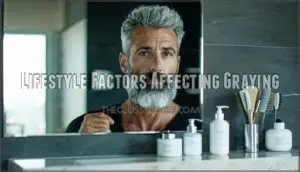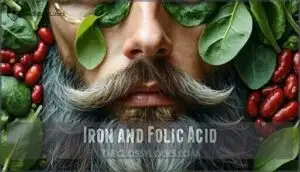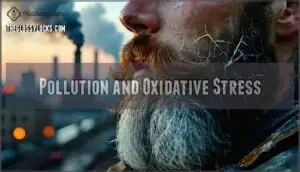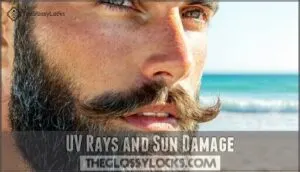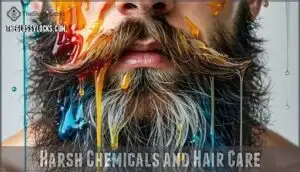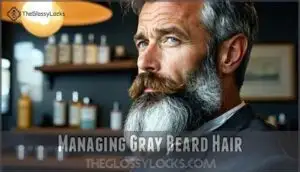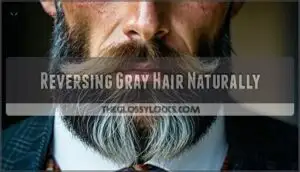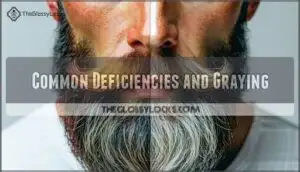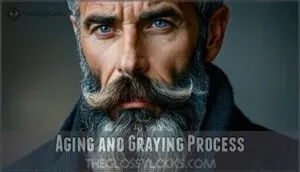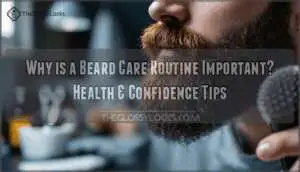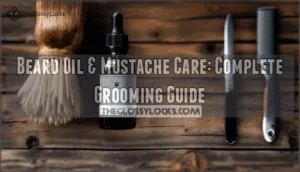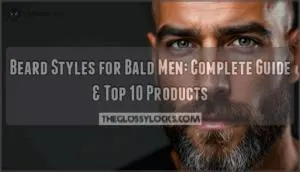This site is supported by our readers. We may earn a commission, at no cost to you, if you purchase through links.
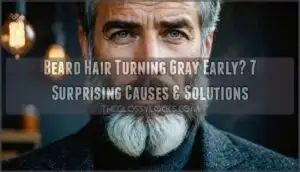 If you’re noticing beard hair turning gray early, you’re not alone in this hairy situation.
If you’re noticing beard hair turning gray early, you’re not alone in this hairy situation.
Several factors can accelerate the graying process, including high stress levels, genetic predisposition, vitamin deficiencies, and smoking habits.
Your family history plays a significant role, as does your body’s melanin production.
Nutritional gaps, particularly B12, iron, and folic acid deficiencies, can fast-track the silver transformation.
Environmental stressors like pollution and harsh chemicals also contribute to premature graying.
The good news? You can take control through stress management, proper nutrition, and lifestyle changes.
Understanding these seven surprising causes opens the door to effective solutions, and by doing so, you can address the root causes of premature graying, ultimately leading to a better understanding of how to prevent or slow down the process, with proper nutrition being a key factor.
Table Of Contents
- Key Takeaways
- Causes of Premature Graying
- Genetic Influence on Graying
- Lifestyle Factors Affecting Graying
- Nutritional Strategies for Hair
- Environmental Factors and Graying
- Managing Gray Beard Hair
- Reversing Gray Hair Naturally
- Common Deficiencies and Graying
- Aging and Graying Process
- Preventing Premature Graying
- Frequently Asked Questions (FAQs)
- Why is my beard turning gray so fast?
- Why is my beard getting white at early age?
- How to stop premature greying of beard hair?
- Should you pluck grey beard hairs?
- Does trimming beard hair prevent premature graying?
- Are there beard dyes safe for sensitive skin?
- Can medical treatments reverse gray beard permanently?
- Does beard oil frequency affect graying speed?
- Conclusion
Key Takeaways
- You can’t escape genetics, but you can fight back – If your dad went gray early, you’ll likely follow suit, but managing stress levels and fixing nutritional deficiencies can slow down the process significantly.
- Your lifestyle choices directly accelerate graying – Smoking, chronic stress, and poor diet create a perfect storm that damages melanin-producing cells, making your beard turn gray years earlier than it should.
- Nutritional gaps are silent gray-hair triggers – Deficiencies in vitamin B12, iron, and folic acid disrupt melanin production, so you’ll need to focus on nutrient-rich foods or supplements to maintain your beard’s natural color.
- You can slow the process with smart daily habits – Regular exercise, stress management techniques like meditation, proper hydration, and avoiding harsh chemicals in grooming products help preserve your follicles’ ability to produce pigment longer.
Causes of Premature Graying
If you’re noticing silver strands in your beard before your 30th birthday, you’re experiencing premature graying that affects millions of men worldwide.
Several factors work together to rob your facial hair of its natural color, ranging from your family’s genetic blueprint to daily stress levels that trigger hormonal changes in your body, which can lead to hormonal changes.
High Stress Levels
Under the pressure of modern life, your body’s fight-or-flight response kicks into overdrive, flooding your system with cortisol.
Chronic stress unleashes a cascade of hormones that literally steal the color from your facial hair, strand by strand.
This stress hormone directly interferes with melanin synthesis, the process that gives your beard its natural color.
Here’s how stress accelerates graying:
- Cortisol production disrupts pigment-producing cells in hair follicles
- Chronic stress depletes melanocytes faster than they can regenerate
- Oxytocin release through stress reduction techniques helps restore natural color production
Genetic Factors
Your genes hold the blueprint for when your beard turns gray. Family history reveals inheritance patterns – if dad went gray early, you likely will too.
The IRF4 gene variant substantially influences premature graying beard timing, while ethnic differences affect melanin production rates.
| Population | Typical Graying Age | Genetic Risk |
|---|---|---|
| Caucasians | Mid-30s | Highest |
| Asians | Late 30s | Moderate |
| African-Americans | Mid-40s | Lowest |
Genetic testing can identify specific markers linked to beard pigmentation loss, helping you understand your melanin production timeline. Lifestyle choices can also influence hair health, so consider essential vitamins and minerals to support beard pigmentation.
Vitamin Deficiencies
Your body needs specific nutrients to maintain beard color, and deficiencies can trigger premature graying beard issues.
Vitamin B12 deficiency, common in vegetarian diets, disrupts melanin production.
Copper deficiency affects essential nutrients needed for pigmentation.
Biotin and graying connect through hair health, while vitamin D supports follicle function.
Consider supplement options for trace elements if you’re experiencing melanin deficiency.
Smoking and Toxins
Smoking accelerates premature graying by flooding your follicles with harmful toxins.
Nicotine effects include reduced blood flow to hair roots, while smoke inhalation creates oxidative damage that destroys melanin-producing cells.
Here’s how toxin exposure wrecks your beard:
- Chemical absorption through skin weakens follicle health
- Nicotine constricts blood vessels, starving hair of nutrients
- Oxidative stress from smoking damages pigment cells permanently
Genetic Influence on Graying
Your genes play the biggest role in determining when your beard starts turning gray, and there’s nothing you can do to change this inherited timeline.
If your dad or grandfather went gray early, you’ll likely follow the same pattern, with genetics accounting for about 30% of all premature graying cases, and this is due to the fact that genetics play a significant role in determining the timeline.
Family History
Your family lineage holds the blueprint for your early gray beard genetics.
If your father or grandfather sported silver whiskers before forty, you’re likely following similar inheritance patterns.
This genetic predisposition accounts for roughly thirty percent of premature graying cases.
Examining your genealogy reveals ancestral graying trends that predict when your beard will lose its color naturally, due to your genetic predisposition.
Ethnicity and Graying
Your ethnic background substantially influences your early gray beard timeline.
Caucasians typically experience premature greying before age 20, while Asians start around 25, and those with African ancestry begin closer to 30.
This ancestry and graying connection stems from genetic predisposition affecting melanin production and pigmentation retention, making ethnicity a key factor in determining when your facial hair loses color.
A recent study indicates varying graying onsets across different racial groups, highlighting the impact of ethnicity on premature greying and facial hair.
IRF4 Gene Variant
The rs12203592 marker within your IRF4 gene directly controls melanin regulation and hair pigmentation.
This genetic variant explains why some people experience premature greying while others don’t.
Your IRF4 function determines melanin production levels, making graying inheritance predictable through gene expression patterns in the graying process.
The IRF4 gene also influences melanocytic naevus count.
- Genetic lottery: You inherit specific IRF4 variants that predetermined your beard’s graying timeline before you were born
- Melanin control: Your gene expression directly regulates how much pigment your hair follicles produce throughout your lifetime
- Family patterns: Examining your relatives’ graying history reveals your genetics-driven future beard color changes
Lifestyle Factors Affecting Graying
Your daily choices create a powerful ripple effect that directly impacts when your beard starts showing silver strands.
From managing workplace stress to choosing what you eat for breakfast, these lifestyle factors work together to either protect your natural hair color or speed up the graying process.
Stress Management
While your genes load the gun, stress pulls the trigger on premature graying.
High cortisol levels from chronic stress directly interfere with melanin production in your beard follicles.
You can fight back with proven stress reduction methods that protect your natural color.
| Stress Management Technique | Impact on Gray Beard |
|---|---|
| Deep breathing exercises | Lowers cortisol, preserves melanin |
| Regular meditation practice | Reduces stress hormones substantially |
| Quality sleep (7-9 hours) | Supports natural hair pigmentation |
| Mindfulness practices | Improves emotional wellbeing, slows graying |
Balanced Diet
Your balanced diet directly impacts beard hair graying by supporting melanin production through essential nutrients.
Dietary deficiencies accelerate premature greying, while nutrient-rich foods combat this process effectively.
Focus on these key dietary strategies:
- Organic foods rich in B vitamins, iron, and antioxidants
- Gut bacteria support through fiber-rich meals for biotin production
- Collagen production boosters like vitamin C and protein sources
Quitting Smoking
Beyond the obvious health risks, cigarettes accelerate premature greying through multiple pathways.
Nicotine acts as a stimulant, elevating stress hormones that disrupt melanin production in your beard follicles.
Toxin exposure from smoking damages the cells responsible for pigmentation, while reduced circulation limits nutrient delivery to facial hair.
Alcohol consumption can also negatively impact hair health, as it can lead to nutritional deficiencies.
| Smoking Effects | Benefits of Quitting |
|---|---|
| Reduced melanin production | Restored natural pigmentation |
| Increased oxidative stress | Improved circulation benefits |
| Accelerated aging process | Enhanced overall health |
Smoking cessation represents one of the most impactful lifestyle changes you can make for beard health.
Nutritional Strategies for Hair
You can’t control genetics, but you can fuel your beard with the right nutrients to fight premature graying.
Your hair follicles need specific vitamins and minerals to produce melanin, the pigment that keeps your beard its natural color.
Iron and Folic Acid
Low iron levels create a perfect storm for premature greying in your beard.
Iron deficiency reduces oxygen flow to hair follicles, while inadequate folic acid disrupts DNA synthesis needed for healthy pigment production.
This anemia link accelerates early graying more than you’d expect.
Boost iron absorption with lean meats, spinach, and legumes.
Add folic benefits through leafy greens and fortified cereals.
Folic acid deficiency, however, can lead to hair loss and thinning.
Omega 3 and Antioxidants
Omega-3 Benefits extend beyond heart health to your beard’s pigmentation.
These essential fatty acids deliver nutrients directly to hair follicles, supporting melanin production while fighting inflammation.
Antioxidant Sources like berries and leafy greens provide Cellular Protection against free radicals that damage pigment cells.
This powerful combination helps Reduce Inflammation and maintains your beard’s natural color through superior Dietary Impact.
Vitamin B12 and D
Getting enough vitamin B12 and vitamin D3 prevents your beard hair from losing its natural color prematurely.
These nutrients support melanin production, the pigment that keeps your beard from turning white too early.
Essential steps for ideal B12 absorption and vitamin D synthesis:
- B12 food sources: eggs, fish, dairy, fortified cereals
- D deficiency risks: limited sun exposure, indoor lifestyle
- Supplement dosage: 2.4mcg B12 daily, 1000-4000 IU D3
- Monitor levels: annual blood tests track deficiencies
Environmental Factors and Graying
Your environment plays a bigger role in premature beard graying than you might think, with daily exposure to pollution, UV rays, and harsh chemicals creating oxidative stress that damages melanin-producing cells.
These external factors accelerate the natural aging process of your facial hair, causing those unwanted gray strands to appear years earlier than they should, due to the damage to melanin-producing cells.
Pollution and Oxidative Stress
City air attacks your beard follicles daily through free radical damage and environmental toxins.
This oxidative imbalance accelerates cellular aging, breaking down melanin-producing cells that keep your whiskers colored.
Pollution creates chronic stress on hair structures, triggering premature gray hair formation.
You can find beard pollution solutions online.
Combat this assault with antioxidant protection through vitamin C, E, and selenium supplements to neutralize harmful compounds, utilizing environmental toxins protection.
UV Rays and Sun Damage
Stepping outside without protection exposes your beard to harmful UV rays that accelerate gray beard causes through melanin depletion.
Sun exposure weakens hair follicles and triggers beard discoloration by damaging pigment-producing cells. You’ll notice faster graying from hair weakening over time.
Sunscreen benefits include preventing UV damage, while protective products with UV protection shield your facial hair from harmful rays. Using beard sunscreen products can mitigate this UV damage.
The use of protective products with UV protection is essential for maintaining healthy facial hair, and applying beard sunscreen regularly can help prevent further damage.
Harsh Chemicals and Hair Care
Your daily hair care routine might be sabotaging your beard’s natural color.
Chemical exposure from sulfates, parabens, and ammonia in conventional products damages melanin-producing cells.
These harsh product ingredients accelerate graying by creating oxidative stress in follicles.
Switch to gentle alternatives without synthetic fragrances or formaldehyde.
Using sulfate-free beard products can help maintain beard health.
Chemical-based products harm hair health more than you realize, leading to the need for gentle alternatives.
Managing Gray Beard Hair
Once you’ve spotted those first gray hairs in your beard, you don’t have to surrender to them completely.
You can slow down further graying and maintain your beard’s health through proper care techniques and smart product choices.
Beard Oils and Moisturizers
Quality beard oils containing jojoba and argan oil offer significant moisturizing benefits for gray facial hair.
These essential oils penetrate hair follicles, providing nourishment while creating healthier growth conditions.
Apply beard oils using gentle massaging techniques to stimulate circulation and distribute nutrients evenly.
Regular beard maintenance with natural moisturizer types helps condition coarse gray hairs, making them more manageable while supporting overall beard grooming routines, which include using natural moisturizer.
Avoiding Harsh Chemicals
While nourishing your beard matters, what you avoid can be equally important.
Your grooming routine might unknowingly accelerate gray beard causes through chemical-based products that damage melanin-producing cells. Many commercial beard products contain harsh sulfates and synthetic fragrances that strip natural oils and weaken hair follicles, contributing to early graying.
- Gentle Grooming: Choose sulfate-free shampoos and alcohol-free beard oils to preserve natural pigment production
- Chemical Alternatives: Replace synthetic products with natural hair care options like argan oil and shea butter
- Natural Products: Look for organic ingredients instead of parabens, artificial colors, and harsh preservatives
- DIY Recipes: Create homemade beard treatments using coconut oil, honey, and essential oils for ingredient awareness
Reversing Gray Hair Naturally
You can’t completely reverse gray hair that’s already lost its pigment, but you can slow down the graying process and support healthy hair growth through targeted lifestyle changes.
Simple adjustments like managing stress levels, eating nutrient-rich foods, and staying hydrated help your hair follicles produce melanin more effectively, which may prevent new gray hairs from appearing, and this can be seen as a way to support healthy hair growth.
Reducing Stress
Managing your beard’s appearance goes beyond external care – your mental well-being directly impacts hair pigmentation.
Chronic stress triggers cortisol production, which interferes with melanin synthesis in hair follicles.
Stress reduction through meditation techniques, regular exercise benefits, and improved sleep quality can slow graying.
Hobby engagement and relaxation techniques help maintain healthy lifestyle habits that support natural hair color retention, promoting overall well-being and stress reduction.
Improving Diet and Nutrition
Your beard turning white often stems from an unbalanced diet lacking essential nutrients.
Nutrient-rich foods packed with dietary antioxidants boost melanin production naturally. Focus on copper-rich organ meats, iron-loaded leafy greens, and trace elements like B12.
These dietary adjustments support gut health and collagen production. Proper hydration benefits hair follicles while antioxidant-rich foods combat free radical damage effectively.
Exercise and Hydration
Getting your blood pumping does more than sculpt your physique.
Regular exercise creates a circulation boost that delivers oxygen and nutrients directly to your follicle health.
Meanwhile, proper water intake helps flush out sweat toxins that can damage melanin production.
The exercise type matters less than consistency.
- Watch your beard turning white slow down as improved blood flow nourishes each follicle
- Feel the confidence surge when stress melts away through regular movement
- Experience the satisfaction of healthy habits working together to preserve your natural color
- Discover how simple hydration transforms your beard’s appearance from the inside out
Common Deficiencies and Graying
You might be surprised to learn that your graying beard could signal nutritional gaps in your diet, particularly deficiencies in vitamin B12 and iron.
These essential nutrients play vital roles in melanin production, and when you’re running low, your facial hair loses its natural pigment faster than it should, which can be related to vitamin B12 deficiencies.
Vitamin B12 Deficiency
Something as simple as missing vitamin B12 can turn your beard hair gray faster than you’d expect.
This essential nutrient directly impacts melanin production, and vegetarian risks run higher due to limited B12 sources in plant-based diets.
Pernicious anemia blocks B12 absorption, accelerating hair health decline.
| B12 Deficiency Signs | Hair Impact | Solution Timeline |
|---|---|---|
| Fatigue, weakness | Premature graying | 3-6 months |
| Tingling hands/feet | Reduced melanin | 2-4 months |
| Memory issues | Brittle texture | 1-3 months |
| Pale skin | Color loss | 4-8 months |
| Shortness of breath | Slow growth | 2-5 months |
Supplement options include sublingual tablets, injections, or fortified foods to restore your beard’s natural color.
Iron Deficiency
Low iron levels wreak havoc on your beard’s melanin production, starving melanocytes of the oxygen they need to create pigment.
When your ferritin levels drop, you’re facing anemia risk that directly impacts beard melanin deficiency. Your body prioritizes essential organs over hair follicles, leaving your facial hair colorless.
- Monitor iron absorption through nutrient-rich foods like spinach and lean meats
- Consider supplementation if dietary iron isn’t meeting your body’s demands
- Test ferritin levels annually to catch deficiencies before graying accelerates
Aging and Graying Process
Your beard’s graying process starts when melanocytes, the cells that produce melanin pigment, begin to slow down and eventually stop working as you age.
Beard hair actually grays faster than head hair because it has a shorter growth cycle, which depletes these pigment-producing cells more quickly and makes gray strands more visible against your facial hair’s coarser texture, leading to a more noticeable effect of gray strands.
Melanin Production
Your hair follicles contain melanocytes, specialized melanin-producing cells that determine hair pigmentation.
These cells control melanin synthesis through genetic programming, creating the pigment that gives your beard its natural color.
When melanocyte function declines, pigment distribution becomes irregular, leading to beard melanin deficiency.
Environmental impacts like stress and toxins can damage these delicate cells, disrupting their ability to produce adequate melanin for consistent hair coloration.
Hair Life Cycle
Understanding how your beard’s natural rhythm works helps explain why gray hairs appear faster than you’d expect.
Your facial hair follows a shorter cycle than scalp hair, which accelerates the depletion of melanocytes responsible for hair pigment.
Here’s what happens during each phase:
- Anagen Duration – Your beard’s growth phase lasts only 2-6 months versus years for scalp hair
- Catagen Phase – Hair follicles shrink rapidly, reducing melanocyte activity and hair pigmentation
- Telogen Shedding – Old hairs fall out while new ones lack sufficient pigment-producing cells
- Cycle Length – Shorter cycles mean faster turnover and quicker loss of follicle health
Visual Prominence of Gray Hair
Regarding the beard aging process, gray hairs stand out like spotlights against darker facial hair.
Your beard’s visual prominence makes graying more noticeable than scalp hair, affecting facial perception and self-perception.
This gray contrast creates immediate social impact, signaling aging signs whether you’re experiencing premature graying or natural beard appearance changes.
| Hair Location | Visibility Factor | Aging Impact |
|---|---|---|
| Beard Center | High contrast | Strong aging signs |
| Chin Area | Maximum exposure | Prominent graying |
| Jawline | Daily visibility | Social perception |
| Mustache | Close-up notice | Self-awareness boost |
Preventing Premature Graying
You can’t completely stop genetic graying, but you can slow down premature beard graying through targeted lifestyle changes and proper nutrition.
Making smart choices about stress management, exercise, diet, and avoiding smoking gives your facial hair the best chance to maintain its natural color longer, which involves proper nutrition.
Healthy Lifestyle Choices
Making smart choices daily can slow your beard’s graying process substantially.
Stress reduction through meditation or hobbies keeps cortisol levels in check.
A balanced diet rich in antioxidants and vitamins supports melanin production.
Quit smoking to reduce toxin exposure that damages hair follicles.
Proper hydration habits maintain healthy hair growth while supporting overall follicle function.
Regular Exercise and Relaxation
Physical activity boosts circulation benefits to your hair follicles, delivering essential nutrients that support melanin production.
While you can’t override genetics, combining exercise with relaxation techniques creates powerful stress reduction that slows premature graying.
Here’s your holistic wellness approach:
- Cardio exercise types: Running, cycling, or swimming improve blood flow to facial hair
- Stress-busting activities: Yoga and pranayama breathing lower cortisol levels naturally
- Recovery practices: Meditation and stretching help your body repair and regenerate
Balanced Diet and Nutrition
Your beard’s color depends on nutrient absorption from a balanced diet rich in vitamins and minerals.
Gut health directly impacts how your body processes nutrients that support collagen production.
Focus on antioxidant intake through colorful vegetables and fruits while maintaining proper hydration benefits.
Nutrient-rich foods containing B vitamins, iron, and antioxidants help preserve your beard’s natural pigmentation longer.
Frequently Asked Questions (FAQs)
Why is my beard turning gray so fast?
Genetics, stress, and lifestyle choices accelerate your beard’s graying process.
High cortisol levels, smoking, poor nutrition, and vitamin deficiencies disrupt melanin production.
Your beard’s faster growth cycle also makes gray hairs more visible sooner, influenced by high cortisol levels.
Why is my beard getting white at early age?
Early beard whitening happens when you’re dealing with genetics, stress overload, or nutritional gaps like B12 deficiency.
Your facial hair follicles stop producing melanin faster than scalp hair, making changes more visible, which can be influenced by factors such as stress overload.
How to stop premature greying of beard hair?
Combat chronic stress through meditation and exercise to preserve melanin production.
You can’t change genetics, but proper nutrition with B12, iron, and antioxidants slows graying.
Quit smoking immediately—it accelerates the process substantially, and with proper nutrition, you can mitigate some of the effects.
Should you pluck grey beard hairs?
Don’t pluck grey beard hairs—you’ll damage follicles and risk ingrown hairs or infection.
Plucking won’t prevent more greys from appearing.
Instead, trim them short or use beard dye for better results.
Does trimming beard hair prevent premature graying?
Trimming your beard won’t prevent premature graying since it doesn’t affect melanin production in hair follicles.
Gray hairs appear due to genetics, stress, and aging—not hair length or cutting frequency.
Are there beard dyes safe for sensitive skin?
Mark discovered natural beard dyes after chemical ones irritated his skin.
Yes, you’ll find gentle options like henna, coffee-based dyes, and ammonia-free formulas specifically designed for sensitive skin that won’t cause redness or burning.
Can medical treatments reverse gray beard permanently?
Currently, no medical treatments can permanently reverse gray beard hair.
Once melanin-producing cells stop functioning, the change is irreversible.
However, you can explore temporary solutions like beard dyes or embrace your distinguished gray look.
Does beard oil frequency affect graying speed?
Your grooming ritual’s frequency won’t accelerate nature’s silver transformation.
Beard oil application – whether daily or weekly – doesn’t influence melanin production or graying speed.
You’re simply nourishing follicles, not affecting your hair’s genetic color timeline, which is influenced by your genetic makeup.
Conclusion
While countless men panic at the first sight of a silver strand, understanding why your beard hair turning gray early doesn’t have to feel like an insurmountable challenge.
You’ve got the power to tackle stress, fix nutritional gaps, and make lifestyle changes that can slow the graying process.
Remember, genetics play a role, but they’re not your destiny.
With proper nutrition, stress management, and consistent care, you can maintain healthier facial hair longer than you might expect.
- https://pubmed.ncbi.nlm.nih.gov/39697103/
- https://onlinelibrary.wiley.com/doi/10.1111/ijd.17580
- https://pmc.ncbi.nlm.nih.gov/articles/PMC6290285/
- https://www.medicinenet.com/can_premature_graying_be_reversed/article.htm
- https://journals.lww.com/idoj/fulltext/2024/15050/premature_graying_of_hair__a_comprehensive_review.1.aspx


